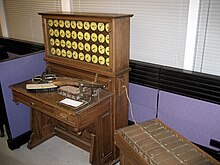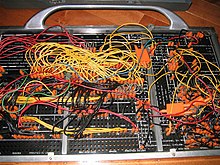Tabulator
The tabulating machine ( English Tabulating machine ) is used to evaluate possibly but not necessarily pre-sorted and / or pre-mixed punch cards . The tabulating machine is its own kind, not to be confused with the booking engine ( English Accounting machine ).
After the first presentation of electromechanical evaluation machines by the inventor Herman Hollerith in 1887, there was constant further development / specialization, also differentiated according to the respective task.
The advantage of the tabulating machine, inextricably linked to the punch card, was the mature, inexpensive, proven and existing technology. Their demise was sealed by the inexpensive emergence of electronic data processing , which offered a full replacement.
The voting machines controversial in the US presidential election in Florida in 2000 were based on paper punched ballot papers and counting machines that are related to tabulating machines.
Data entry
Manual input
The data was entered manually at the beginning , each punch card was inserted into the machine by hand and removed again by hand after the evaluation.

Machine input
The Tabulating Machine Company supplied the automatic feeding of the punch card into the tabulating machine in 1906. A speed of 150 cards per minute is documented.
To process
counting
The first tabulating machine was originally designed and used for the 1887 census in the United States. Here punch cards were inserted by hand and the data was counted according to the program. The wired program also made it possible to count the combinations of individual data (for example: number of black women over 50 in NY or LA ).
Adding, subtracting

From the 1920s onwards, these devices contained adding units that "added and subtracted a little later according to the Leibniz counting wheel principle and parallel to the digits". This expanded their area of application, because addition and subtraction are basic skills that are required for account management in bookkeeping or warehousing .
Multiplication / division
In 1936 multiplication and division were integrated. The "D11 age" begins. This enabled processes such as invoicing (quantity times price), payroll accounting (hours times money) or interest calculation .
ballistics
At the University of Philadelphia in 1944 ballistic tables were calculated on behalf of the army - primers for the artillery, which recorded the trajectory of the various projectiles for guns. The calculation was done by hand. The only help was a tabulator that could multiply and divide. The employees who did the math were named after their job - computers (calculators).
Additional computer
From the fifties, the electromechanically slow multiplication / division was outsourced to connected additional computers that calculated decimal based on tube technology. “Multiplications and divisions take a lot more time than simple balancing. In order to drastically shorten this time, the "electronic computer" BULL GAMMA 3 could be connected. " Heinz Nixdorf developed such computers in his laboratory for pulse technology, among others for Bull .
output
Read off
The data output took place in the early form on readable counters. The operating personnel saved the data on forms or cheat sheets, among other things using ink on paper .
To press
In 1920 CTR (today IBM) introduced a "printing tabulator", a printing tabulator. This increased the speed and avoided sources of error, because the operators had to read the counters beforehand and, among other things, record the results on tally sheets .
While endless tables were initially produced using line printers , there was a further development in 1936, the "line machine", which controlled the "form feed" and could, for example, create multi-page invoices, with the letterhead with address and invoice items on the first sheet and on the following pages the transfer of claims with further invoice items followed.
An example from the 1950s can be seen here "Printing mechanism of the tabulating machine" at Heribert Müller ". The printers were often part of the tabulation machine, rarely peripheral devices.
Punching / punching
Another way to output the results was to punch them on punch cards with a punch card. The monthly billing data were interesting for bookkeeping on punched cards. The open item accounting and payment transactions were handled with additional stacks of punched cards.
programming
Soldered
The programs were inflexible because they were originally firmly soldered.
Pegboard
- Later they were connected to a pegboard with cables attached,
- and implemented in later further development using interchangeable plug-in boards.
It was only in the last development stage that different applications such as payroll, invoicing, etc. could be flexibly "run".
The pegboard was simply changed.
Group control
Group control was introduced around 1914, which enabled the “group-based handling of punch cards”. Next "It allows ... to reproduce the figures in an orderly manner".
Around 1930 the tabulating machine BK (“Bank”) was introduced “It had three so-called intermediate aisles which, depending on the group control, allowed, among other things, sum transfers and lateral additions”.
“The decisive factor was its internal architecture: counting and writing mechanisms with eleven digits, an expanded, three-stage group control (20 columns) and expanded programming with now nine instead of three intermediate steps. In addition, the intermediate courses could be repeated (depending on the result) and their number multiplied ”Heading to the tabulator D11 :“ High-Tech of the 30s ”.
Group change
The principle of electromechanical pegboard programming consisted of routing certain data fields from the punched cards that were read into the counter or writing mechanism, linking them to the rest of the counters using controllable functions, and stringing together the data generated in the counters in order to form the content of the next output line. In addition to the basic arithmetic operations, possible functions were also branches, v. a. the so-called "group change" by querying a "group field".
RPG
“In order to facilitate the switch from traditional punch card processing to electronic data processing , the high-level language RPG was developed and was available on many (IBM) computers from the 1960s onwards. Its syntax was based on the way tabulating machines work, but the tedious cabling on breadboards has given way to writing source code and compiling . "
Web links
- private page to the Hollerith machine
- private page about punch card technology in the GDR
- Hollerith 1890 Census tab
- IBM: [ IBM 407 Accounting Machine: Manual of Operation (PDF; 26.7 MB) IBM 407 Accounting Machine: Manual of Operation] 1953, 22-5765-7.
Individual evidence
- ^ "Heinz Nixdorf Museum Forum shows Hollerith machine." Heise online, May 10, 2007 .
- ^ "The hole in power." Spiegel online Politik, October 29, 2004 .
- ^ IBM: "first automatic feed tabulator" IBM Archive 1906 in English .
- ^ A b Stefan Winterstein: "From Hollerith to IBM - The History of Commercial Data Processing." Paper, 1991/92.
- ↑ a b IBM: "History" .
- ↑ As a computer female, Süddeutsche Zeitung FROM ISSUE 41/2015 TECHNIK.
- ↑ Dipl. Phys. H. Müller: "1st generation tube computer: BULL GAMMA 3." In the "technikum29" museum.
- ↑ IBM: "printing tabulator" IBM Archive 1920 in English.
- ↑ Dipl. Phys. H. Müller: "Bull tabulating machine." In the museum "technikum29.
- ↑ Charles M. Province: "IBM punch card system in the US Army." In English.
- ^ The history of machine data processing, Volume 1: IBM Encyclopedia of Information Processing, IBM Form D 12-0028 (3/91), page 37
- ↑ The history of machine data processing, Volume 1: IBM Encyclopedia of Information Processing, IBM Form D 12-0028 (3/91), page 40.
- ↑ The history of machine data processing, Volume 1: IBM Encyclopedia of Information Processing, IBM Form D 12-0028 (3/91), page 41.
- ↑ The history of machine data processing, Volume 1: IBM Encyclopedia of Information Processing, IBM Form D 12-0028 (3/91), pages 42–43.
- ↑ "RPG: Bridge from the pegboard to the database". In: The history of machine data processing. Volume 1: IBM Encyclopedia of Information Processing, IBM Form D 12-0028 (3/91), pages 140-141.
